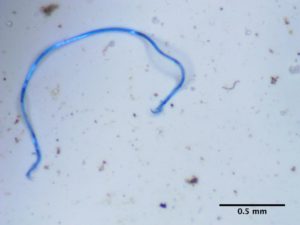 This is part 2 of posts about tiny particles of plastic (microfibers) in our water - which is a form of water pollution. These plastic fibers are smaller than 5 mm, and are found in water (drinking water, rivers, oceans) throughout the world. An investigative study by Orb Media (done by research scientists) took numerous drinking water samples from more than a dozen nations and analyzed them. They found that 83% of drinking water samples worldwide, and 94% of drinking water samples taken in the US (which included tap water from Congressional buildings, the US Environmental Protection Agency’s headquarters, Trump Tower in New York, and bottled waters) contained plastic microfibers.
This is part 2 of posts about tiny particles of plastic (microfibers) in our water - which is a form of water pollution. These plastic fibers are smaller than 5 mm, and are found in water (drinking water, rivers, oceans) throughout the world. An investigative study by Orb Media (done by research scientists) took numerous drinking water samples from more than a dozen nations and analyzed them. They found that 83% of drinking water samples worldwide, and 94% of drinking water samples taken in the US (which included tap water from Congressional buildings, the US Environmental Protection Agency’s headquarters, Trump Tower in New York, and bottled waters) contained plastic microfibers.
The last post discussed research finding plastic microfibers in rivers, and how they are now found in fish and shellfish - and so eventually in us (we eat fish and shellfish, don't we?). The plastic microfibers are in our food chain, and there is tremendous concern over what that is doing to wildlife and to us, especially as the microfibers accumulate. Well, we also now know that the plastic microfibers are found in drinking water, are in the air, and can be found in foods tested (even beer).
So what are these plastic microfibers doing to us? And how can we reduce the number of microfibers being released into the air? The Orb Media site discusses sources of plastic microfibers in the environment (from clothes being washed, tire dust, paint dust, etc.) to how we personally can generate fewer plastic microfibers (try not to use plastic bags or straws, etc.). Excerpts from The Guardian:
Plastic fibres found in tap water around the world, study reveals
Microplastic contamination has been found in tap water in countries around the world, leading to calls from scientists for urgent research on the implications for health. Scores of tap water samples from more than a dozen nations were analysed by scientists for an investigation by Orb Media, who shared the findings with the Guardian. Overall, 83% of the samples were contaminated with plastic fibres.
The US had the highest contamination rate, at 94%, with plastic fibres found in tap water sampled at sites including Congress buildings, the US Environmental Protection Agency’s headquarters, and Trump Tower in New York. Lebanon and India had the next highest rates. European nations including the UK, Germany and France had the lowest contamination rate, but this was still 72%. The average number of fibres found in each 500ml sample ranged from 4.8 in the US to 1.9 in Europe.
The new analyses indicate the ubiquitous extent of microplastic contamination in the global environment. Previous work has been largely focused on plastic pollution in the oceans, which suggests people are eating microplastics via contaminated seafood. “We have enough data from looking at wildlife, and the impacts that it’s having on wildlife, to be concerned,” said Dr Sherri Mason, a microplastic expert at the State University of New York in Fredonia, who supervised the analyses for Orb. “If it’s impacting [wildlife], then how do we think that it’s not going to somehow impact us?”
Mahon said there were two principal concerns: very small plastic particles and the chemicals or pathogens that microplastics can harbour. “If the fibres are there, it is possible that the nanoparticles are there too that we can’t measure,” she said. “Once they are in the nanometre range they can really penetrate a cell and that means they can penetrate organs, and that would be worrying.” The Orb analyses caught particles of more than 2.5 microns in size, 2,500 times bigger than a nanometre. [NOTE: This means they were not able to test for smaller sizes.]
The scale of global microplastic contamination is only starting to become clear, with studies in Germany finding fibres and fragments in all of the 24 beer brands they tested, as well as in honey and sugar. In Paris in 2015, researchers discovered microplastic falling from the air, which they estimated deposits three to 10 tonnes of fibres on the city each year, and that it was also present in the air in people’s homes.
How microplastics end up in drinking water is for now a mystery, but the atmosphere is one obvious source, with fibres shed by the everyday wear and tear of clothes and carpets. Tumble dryers are another potential source, with almost 80% of US households having dryers that usually vent to the open air. “We really think that the lakes [and other water bodies] can be contaminated by cumulative atmospheric inputs,” said Johnny Gasperi, at the University Paris-Est Créteil, who did the Paris studies. “What we observed in Paris tends to demonstrate that a huge amount of fibres are present in atmospheric fallout.”.... Plastic fibres may also be flushed into water systems, with a recent study finding that each cycle of a washing machine could release 700,000 fibres into the environment. Rains could also sweep up microplastic pollution, which could explain why the household wells used in Indonesia were found to be contaminated.
 Microfibers found in the Hudson River. Credit: PBS News Hour, Sara Cathey, Adventure Scientists
Microfibers found in the Hudson River. Credit: PBS News Hour, Sara Cathey, Adventure Scientists
